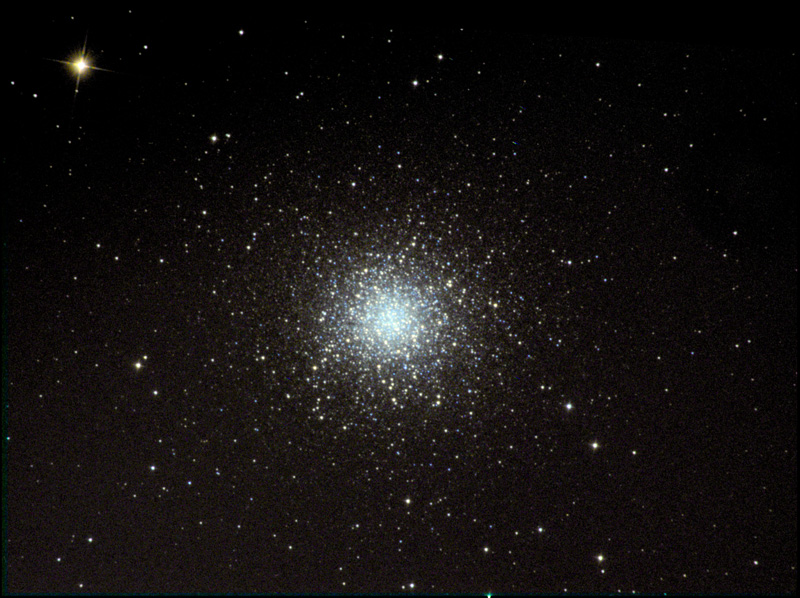

Image Centered on Ra. 16 : 41.7 (h:m) Dec. +36 : 28 (deg:m)
M13 (NGC 6205)
Information (From the SEDS online website)
Discovered by Edmond Halley in
1714.
M13, also called the `Great globular cluster in Hercules', is one of the most
prominent and best known globulars of the Northern celestial hemisphere. It was
discovered by Edmond Halley in 1714, who noted that `it shows itself to the
naked eye when the sky is serene and the Moon absent.' According to Charles
Messier, who cataloged it on June 1, 1764, it is also reported in John Bevis'
"English" Celestial Atlas.
At its distance of 25,100 light years, its angular diameter of 20' corresponds
to a linear 145 light years - visually, it is perhaps 13' large. It contains
several 100,000 stars; Timothy Ferris in his book Galaxies even says "more than
a million". Towards its center, stars are about 500 times more concentrated than
in the solar neighborhood. The age of M13 has been determined by Sandage as 24
billion years and by Arp as 17 billion years around 1960; Arp later (in 1962)
revised his value to 14 billion years (taken from Kenneth Glyn Jones).
According to Kenneth Glyn Jones, M13 is peculiar in containing one young blue
star, Barnard No. 29, of spectral type B2. The membership of this star was
confirmed by radial velocity measurement, and is strange for such an old cluster
- apparently it is a captured field star.
Observers note 4 apparently star-poor regions in M13 (e.g., Mallas). Suggestions
of them can be noted in some photos.
Globular cluster M13 was selected in 1974 as target for one of the first radio
messages addressed to possible extra-terrestrial intelligent races, and sent by
the big radio telescope of the Arecibo Observatory.
Nearby, about 40 arc minutes north-east of M13, is the faint (mag 11) galaxy NGC
6207, visible in many large- and medium-size-field photographs of M13,
Optics - Exposure information
Telescope, Vixen R200ss 8 inch Newtonian at F4 (Fl 800mm) with a Televue Coma Corrector and aftermarket Moonlite accessories focuser.
Mount, Losmandy G11 with Gemini control electronics
Imager, Starlite-Xpress SXV-h9 using Astronomiks RGB filters
Exposure data. Luminance 30 minutes 60 sec subexposures RGB 15 minutes each 60 sec subexposures
Images acquired with Astroart and aligned then combined in Maxim Dl. Final RGB composite processed with Photoshop Cs
Images acquired from my backyard - " Dirt Clod Observatory" in Antelope California